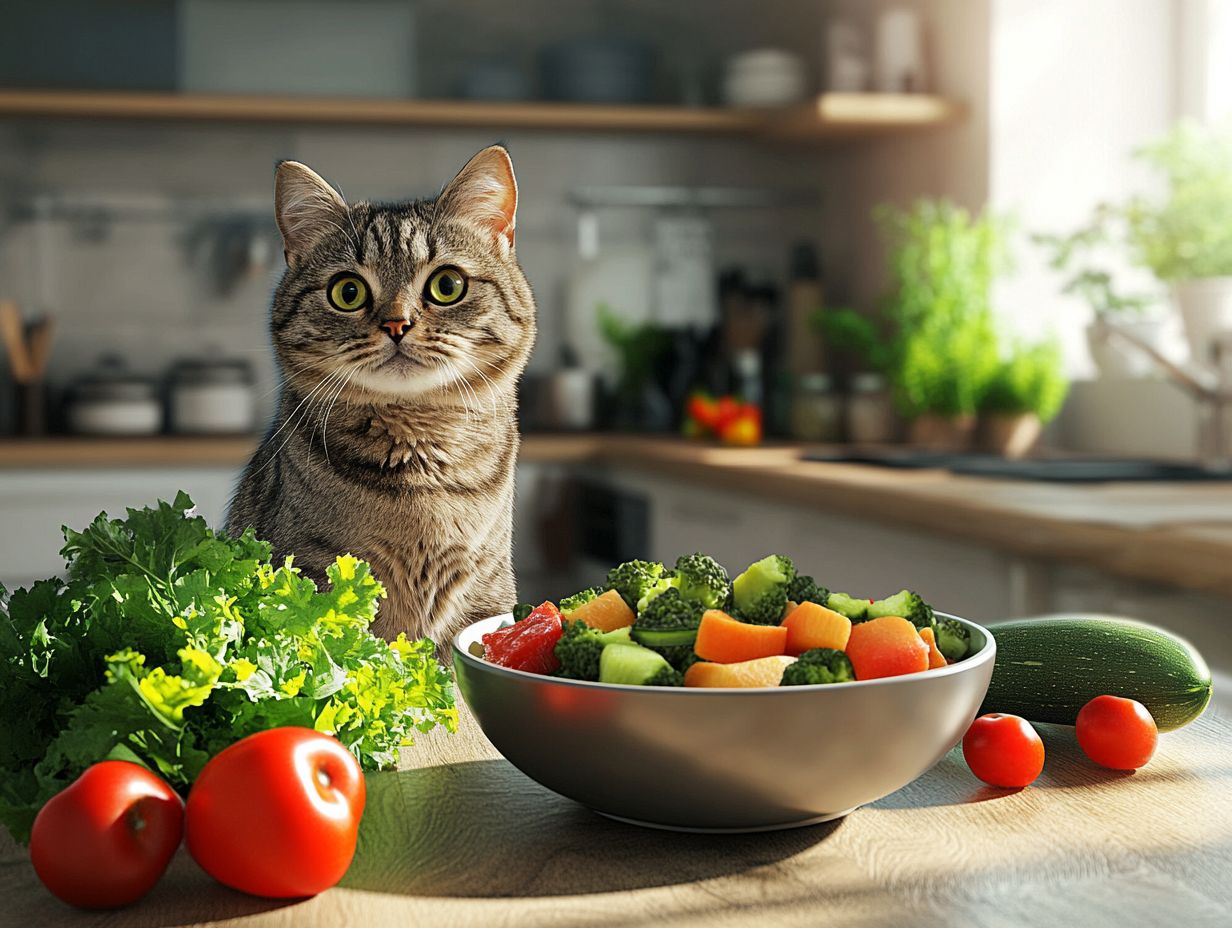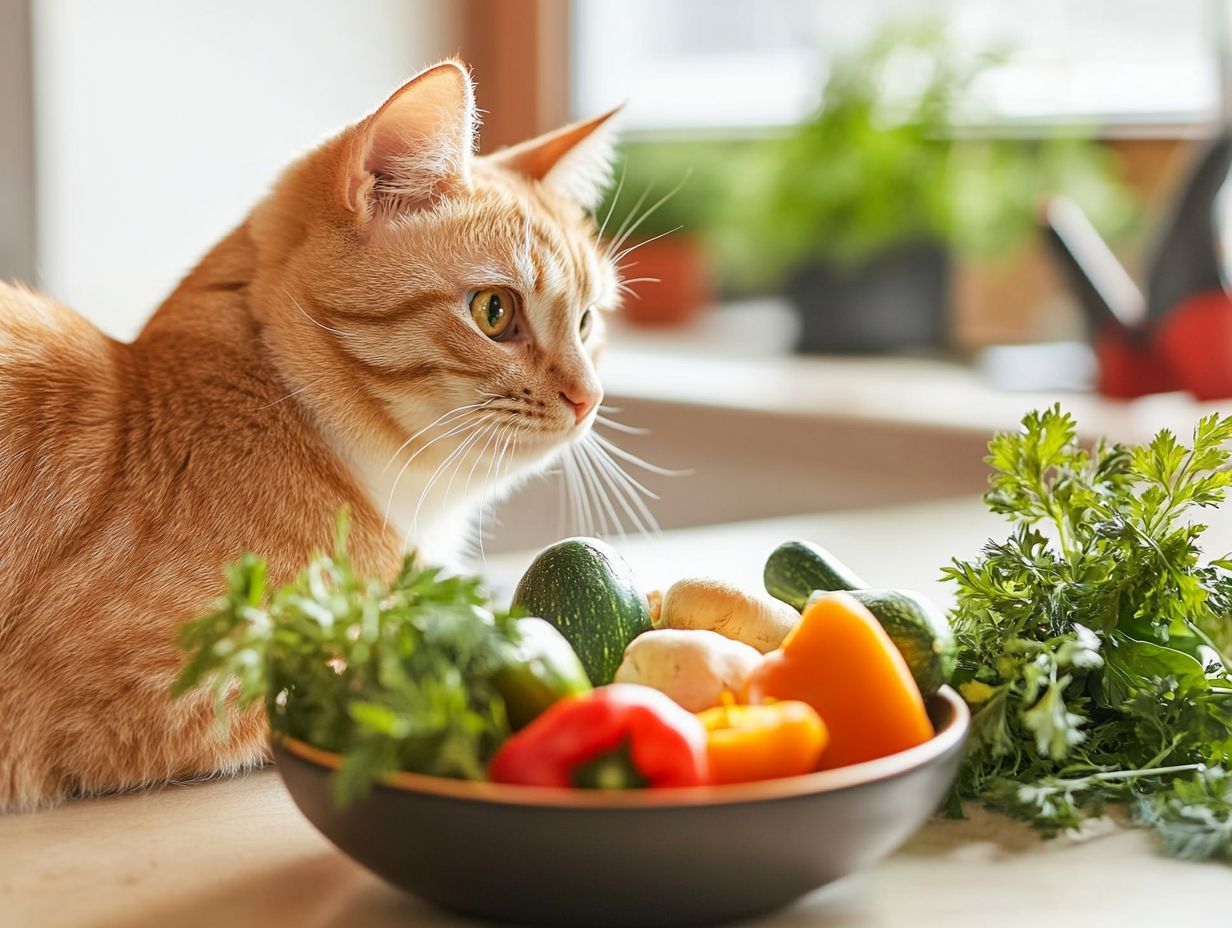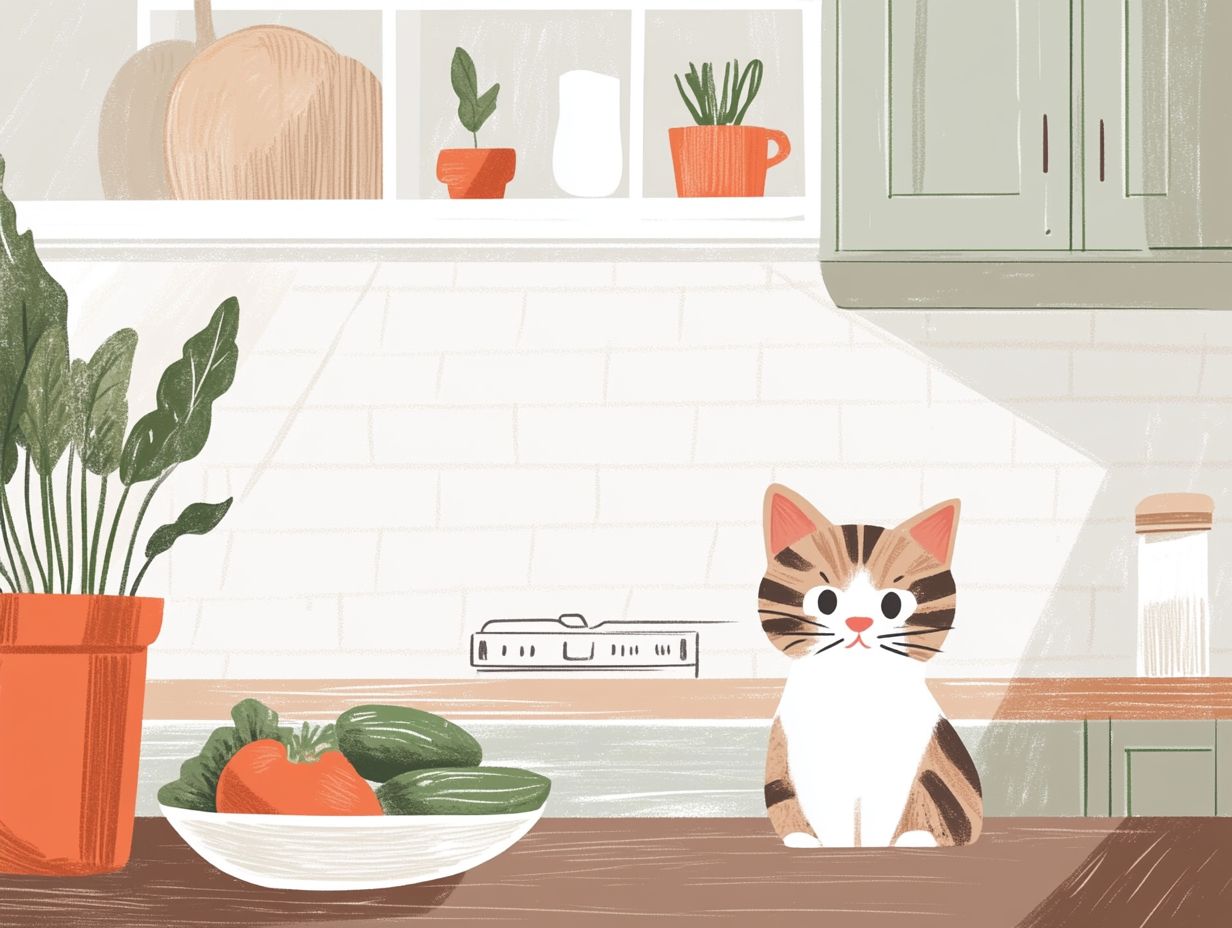In a world where pet health is increasingly prioritized, understanding high-quality commercial cat food is essential for maintaining your feline friend’s weight. While some brands are marketed as natural, it’s important to ensure these foods meet AAFCO standards for balanced nutrition.
This article explores the significance of weight management for cats and how calorie-controlled diets formulated to support weight loss can make a difference.
Discover the nutritional benefits of high-quality commercial cat food, key ingredients to prioritize, and practical feeding tips to help your cat achieve and maintain a healthy weight.
Dive in to learn how to transform your cat’s diet for optimal health and happiness!
Disclaimer: Always consult with a veterinarian before making significant dietary changes, especially for cats with preexisting health conditions.
Key Takeaways:

What Is High-Quality Commercial Cat Food?
High-quality commercial cat food is specifically formulated to meet the unique dietary needs of cats and is crafted from high-quality ingredients that promote weight loss and overall feline health. An increasing number of cat owners are opting for brands such as Hill’s Science Diet and Nulo Freestyle, which frequently exceed AAFCO requirements for nutritional adequacy.
These foods contain lean meats and other nutrient-dense ingredients that provide a balanced, high-quality diet, aiding in healthy weight loss and reducing the risk of obesity-related health issues.
Why Is Weight Management Important for Cats?
Weight management is crucial for cats as it significantly impacts their overall health and helps prevent various health issues, including feline diabetes and obesity.
Ensuring a healthy weight involves providing a balanced diet and regular exercise, which is a key responsibility for cat owners to promote their pets’ long and healthy lives.
Veterinary nutritionists emphasize that understanding a cat’s calorie requirements and body condition score is essential for developing meal plans that encourage weight loss and prevent obesity.
What Are the Nutritional Needs of Cats at Different Life Stages?
Kittens, senior cats, and pregnant or nursing cats have specific nutritional needs that differ from adult cats. Kittens require higher protein and fat levels for growth, while senior cats may need diets lower in calories but higher in fiber to maintain a healthy weight. Pregnant or nursing cats require increased caloric intake to support their kittens.
What Are the Benefits of High-Quality Commercial Cat Food for Weight Management?
High-quality commercial cat food can aid in weight management, making it an excellent choice for cat owners who wish to help their feline companions maintain a healthy weight. These foods are rich in high-quality protein sources and contain sufficient fiber, which helps regulate a cat’s calorie intake while ensuring the diet remains nutritionally balanced.
Additionally, the inclusion of moisture-rich ingredients supports hydration, a crucial factor for proper digestion and metabolism, and is essential for effective weight loss and management.
1. Provides Proper Nutrition
High-quality commercial cat food offers the proper nutrition that aligns with a cat’s unique dietary requirements, providing essential protein sources and fiber necessary for optimal health. This nutrition is crucial for enhancing the overall quality of life for cats, as these components are vital for maintaining a healthy weight and preventing obesity.
High-quality proteins support muscle growth and daily energy needs, while fiber aids digestion and can help keep a cat feeling full for longer periods. When these ingredients meet or exceed AAFCO standards for nutritional adequacy, pet owners can be confident that they are fulfilling their cats’ dietary needs, thereby improving their quality of life.
2. Contains Fewer Calories
One of the major benefits of high-quality commercial cat food is its decreased caloric density, making it ideal for weight loss and maintenance. Lower caloric content is essential for maintaining a healthy weight, particularly in cats that struggle with obesity.
Fat and calorie levels can be tracked and compared across different food brands. For instance, Wellness and Blue Buffalo offer low-calorie commercial diets that promote weight loss while delivering essential nutrients for optimal health.
These low-calorie cat food diets often include high-quality protein sources, which help maintain muscle mass while providing a sense of fullness. By offering low-calorie diets, pet parents can support their cats in losing and maintaining a healthy weight.
Safety and Handling of Cat Food
It is crucial to properly store and handle cat food to prevent spoilage. Ensure that food is kept in a cool, dry place and check for expiration dates. Once opened, high-quality cat food should be stored in an airtight container to maintain freshness.
Potential Risks of Homemade Diets
Feeding homemade diets without veterinary guidance can lead to nutritional deficiencies and health risks. It is essential to consult with a veterinarian to ensure a balanced diet that meets all of a cat’s nutritional needs.
3. Helps with Digestion

Natural cat food often contains d dietary fiber, such as psyllium or beet pulp, which play a significant role in promoting healthy digestion and managing weight in cats. Fiber aids in regulating the speed at which food moves through the digestive tract, reducing the likelihood of hairballs and constipation.
Furthermore, fiber can assist cats in maintaining a healthy weight by providing satiety, thus reducing the chance of overeating. The moisture content in wet food is also essential for digestive health, particularly for older cats, as proper hydration ensures optimal gastrointestinal function.
To compensate for declining metabolism often seen with age, a well-balanced diet tailored to each life stage is crucial for a cat’s overall health and well-being.
4. Promotes a Healthy Coat and Skin
A well-balanced, natural cat food supports weight management and promotes a healthy coat and skin thanks to its high-quality nutrients. Essential fatty acids, including omega-3 and omega-6, are crucial for maintaining skin hydration and elasticity, reducing inflammation and supporting a glossy hair coat.
Antioxidants such as vitamins A and E contribute to cellular repair and protect against environmental stressors. A deficiency in these nutrients may lead to common skin issues such as dryness, itching, and increased shedding.
By incorporating nutrient-rich ingredients, you can significantly enhance your cat’s skin health and help them avoid the discomfort linked to improper nutrition.
What Are the Key Ingredients to Look for in Natural Cat Food for Weight Management?
When selecting a natural cat food for weight control, it is vital to understand how various ingredients can impact your cat’s health and nutritional needs.
1. High-Quality Protein Sources
High-quality protein sources are essential in natural cat food as they support muscle maintenance and overall weight management. Adequate protein intake provides energy for a cat’s active lifestyle and enhances their feeling of fullness, which can help prevent overconsumption.
Lean meat options, such as chicken, turkey, and fish, provide the essential amino acids that cats need for optimal health. Diets lacking animal-sourced proteins can lead to deficiencies, affecting overall health. Brands like Blue Buffalo, Wellness, and Nutro are recognized for their commitment to sourcing high-quality ingredients that ensure every meal is both nutritious and beneficial.
2. Low Carbohydrate Content
A low carbohydrate content is a crucial aspect of natural cat food, as it promotes weight loss and helps maintain appropriate energy levels. Since cats are obligate carnivores, they thrive on diets that are lower in carbohydrates. Excessive carbohydrates can lead to unwanted weight gain, negatively impacting mobility and overall health.
It’s important to note that a lower carbohydrate diet can help sustain optimal energy levels, reducing the risk of fluctuations that may cause lethargy. Ideally, weight loss diets for cats should contain about 10-15% carbohydrates, with energy primarily derived from high-quality protein.
Veterinarians recommend that owners regularly monitor their cats’ responses to dietary changes and adjust nutrients as needed to ensure a healthy weight and energy levels. Always consult with a veterinarian before making significant dietary changes, especially for cats with health conditions.
3. Essential Vitamins and Minerals
Natural cat food should be rich in essential vitamins and minerals to meet dietary needs without compromising nutritional adequacy. These vital nutrients are critical for a feline’s metabolism, supporting everything from healthy skin and fur to optimal immune function.
For example, taurine is an amino acid critical for heart health, while vitamins A and E contribute to vision and reproductive health, respectively. Additionally, minerals like calcium and phosphorus are essential for maintaining strong bones and teeth.
When examining ingredient lists, look for organic fruits, vegetables, and high-quality proteins, as these often indicate a good source of crucial nutrients. Educated choices can promote vibrant health and vitality in your feline companions.
4. Limited or No Fillers
It is advisable to choose cat foods with limited or no fillers, as these can dilute the nutritional quality of the diet. Fillers like corn and wheat provide little nutritional value and can contribute to weight gain if consumed in excess.
Finally, always ensure to store cat food properly to prevent spoilage. Keep it in a cool, dry place and be aware of signs of food spoilage, such as an off smell or changes in texture.

A high-quality natural cat food should contain limited or no fillers, as these can diminish the overall nutritional quality and effectiveness of the food. Fillers are often lower-quality ingredients, such as corn, wheat, or soy, that offer little nutritional value. While some studies show that these ingredients may not be harmful in moderation, excessive reliance on them can lead to an imbalance of essential nutrients necessary for a cat’s health (source).
Discerning cat owners should check the top of the ingredient list for these fillers, as they are often used in larger quantities. Nutritional experts recommend avoiding fillers, especially for those managing a cat’s weight, as they can add calories without providing the proteins, fiber sources, and vitamins essential for healthy weight loss or maintenance. Selecting weight loss foods can help meet calorie needs effectively.
What Are Some Tips for Feeding Natural Cat Food for Weight Management?
Feeding natural cat food for weight control requires strategic practices that consider both the composition of meals and the timing and methods of feeding your cat, including the use of both wet food and dry food to ensure nutritional adequacy.
Disclaimer: It is essential to consult with a veterinarian before making any significant dietary changes, particularly for overweight or health-compromised cats.
Characteristics of High-Quality Natural Cat Food
High-quality natural cat food should prioritize animal-source proteins to support cats’ obligate carnivore nature. Look for ingredients such as chicken, turkey, or fish as the primary protein source, and avoid foods with excessive fillers or artificial additives.
1. Measure Portions
Portion control is a fundamental aspect of weight management for cats. Food portions should be tailored to meet each cat’s individual calorie requirements and consider calorie content. Effective portion control not only involves the quantity of food but also an understanding of its nutritional composition, which should be adjusted according to the cat’s age, activity level, and overall health. For instance, kittens generally need about 100 calories per pound of body weight, while senior or less active cats may require around 20 calories per pound. Utilizing an automatic feeder or feeding ball can help manage feeding habits.
Many cat owners may not realize that even a small amount of overfeeding can lead to significant weight gain over time. Therefore, it is essential to adhere to the feeding guidelines established by veterinary nutritionists, who provide recommendations based on the specific needs of each cat.
This approach ensures that cats receive balanced diets that offer proper nutrition without excess calories. Following these feeding guidelines is crucial not only for weight management but also for promoting long-term well-being and reducing the risk of obesity-related diseases and health problems.
2. Limit Treats
While cat treats can be beneficial during weight loss, they can also lead to excessive calorie intake if not given in moderation. To support healthy weight loss, cat owners should select treats that are nutritionally appropriate, low in calories, and still appealing to their pets. Choosing high protein treats can help maintain muscle mass without compromising a healthy diet.
Clarifying the appropriate types and amounts of treats can support weight management. High protein treats should contain at least 70% protein and should be offered sparingly—generally no more than 10% of your cat’s daily caloric intake. It’s best to avoid those with excessive fillers, artificial colors, or additives. Instead of relying solely on food treats as rewards, engaging in playtime, short training sessions, or using feeding schedule tools can help strengthen the physical and emotional bond with your pet.
Setting clear limits on the quantity of treats and opting for high-quality choices ensures that treat time remains both responsible and rewarding, without compromising affection.
3. Monitor Weight and Adjust as Needed
Regularly monitoring your cat’s weight and body condition score is essential for effective weight management, allowing you to adjust the feeding plan as needed. This process involves more than merely weighing your cat; it also includes assessing body shape and fat distribution using a standardized scoring system. Ideally, weight loss should not exceed 1-2% of body weight per week to ensure safe and effective weight management. Consulting with veterinary nutritionist experts can further aid in achieving the ideal weight.
Pet owners should observe a waist that is narrower than the chest, ribs that can be felt with slight pressure, and a tucked abdomen when viewing the cat’s body shape from the side and above. Signs of weight gain may include an increased abdomen size, a greater than normal waist-to-chest ratio, and difficulty feeling the ribs. Conversely, unintended weight loss might present as a more prominent spine or hip bones.
Recognizing these subtle changes is crucial, and if any concerning patterns emerge, consulting a veterinary nutritionist can help modify the diet to suit your cat’s individual health needs.
4. Consider Adding Supplements
If certain nutrients are lacking in your cat’s diet, adding supplements may be beneficial. However, it’s important to understand the necessity, safety, potential side effects, and appropriate dosages, referencing AAFCO standards where applicable. Always consult your veterinarian before introducing any supplements.
5. Importance of Hydration
Hydration plays a vital role in any weight management plan. Wet food can help support hydration, especially for cats that may not drink enough water. Ensure fresh water is always available, and consider incorporating wet food into your cat’s diet to support overall health.
Common Signs of Nutritional Deficiencies
When managing a cat’s diet, it’s essential to watch for signs of potential nutritional deficiencies. Cats may experience health issues on raw or vegan diets if not carefully balanced. Common signs include lethargy, poor coat condition, and digestive issues. Always consult with a veterinarian if you notice these symptoms.
Additionally, ensure proper food storage and handling to prevent spoilage. Look for signs of spoilage in both wet and dry cat food, such as changes in smell, texture, or color, to avoid health issues.
Supplements like L-carnitine can be beneficial additions to natural cat food for weight loss, as they help enhance metabolism and overall health. This amino acid is essential for transporting fatty acids into cells, allowing them to be burned for energy, which can result in lower body fat percentages. (Reference: [Veterinary Journal, 2021])
For example, omega-3 fatty acids are another valuable supplement that supports hydration by improving skin and coat health and promoting joint health. These fatty acids help maintain optimal moisture levels in the skin and reduce inflammation in joints, which can enhance mobility. Incorporating these supplements into a natural feeding strategy can enhance nutrient absorption and ensure proper hydration in cats, both of which are crucial for a successful weight loss program endorsed by AAFCO guidelines.
Frequently Asked Questions

What is natural cat food for weight management?
Natural cat food for weight management is a type of cat food that is made with all-natural ingredients and is specifically formulated to help cats maintain a healthy weight.
Why is natural cat food better for weight management?
Natural cat food can be better for weight management as it is made with high-quality ingredients that are easily digestible and provide essential nutrients without added fillers or artificial preservatives. However, individual cat needs may vary, and some cats may require specialized diets due to health conditions.
What are some ingredients to look for in natural cat food for weight management?
Look for natural cat food that is high in protein and low in carbohydrates, particularly from animal-source proteins, as cats are obligate carnivores and need animal-based nutrients for optimal health. Ingredients like whole meats, fruits, and vegetables will help keep your cat feeling full and satisfied without consuming excess calories.
How can natural cat food help with weight management?
Natural cat food can help with weight management by providing your cat with a balanced diet that is rich in nutrients and free from artificial additives. This can help prevent overeating and promote a healthy weight.
Are there any specific diet tips for weight management in cats?
Yes, some diet tips for weight management in cats include feeding smaller, more frequent meals, limiting treats, and incorporating interactive playtime to keep your cat active. Additionally, consulting with a veterinarian to tailor dietary plans based on individual cat needs can contribute significantly to weight management.
Can all cats benefit from a natural cat food diet for weight management?
While many cats can benefit from a natural cat food diet for weight management, individual dietary needs may vary, particularly in senior or special-needs cats. It is always best to consult with your veterinarian before making any dietary changes for your cat, especially if they have any underlying health conditions.
Are there risks associated with over-supplementation?
Yes, over-supplementation can lead to health issues. It is important to adhere to proper dosages and be aware of potential side effects that could arise from excessive use of supplements.
Recognizing Obesity in Cats
Being aware of potential signs of obesity in cats, such as difficulty in grooming, lethargy, or difficulty in movement, is crucial. Regular veterinary check-ups are essential for effective weight management and overall health.
Consultation with a Veterinarian
Always consult with a veterinarian before starting any supplementation, especially for weight management or specific health conditions.